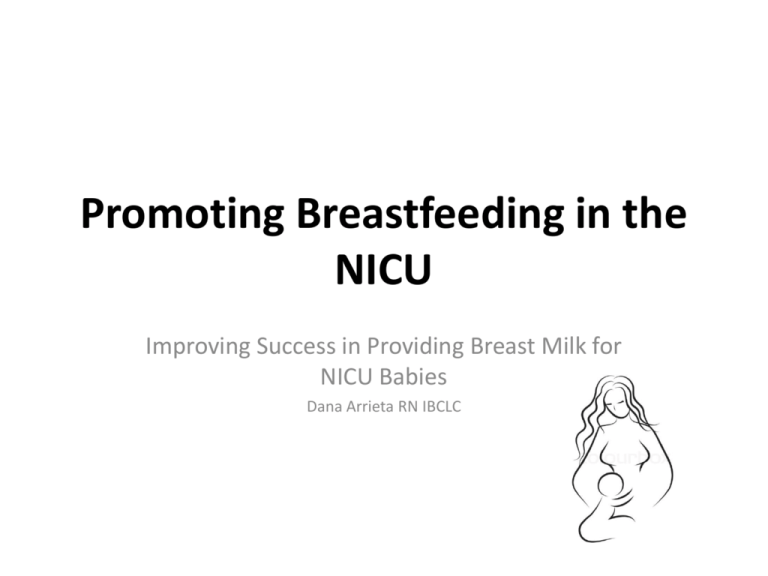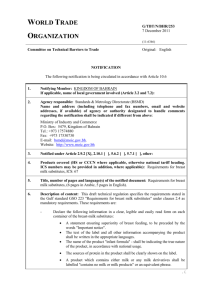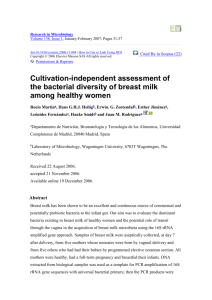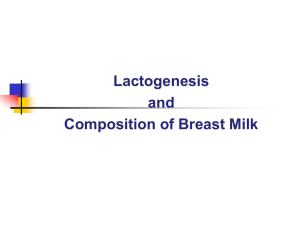Dana Arrieta, RN, IBCLC.
advertisement

Promoting Breastfeeding in the NICU Improving Success in Providing Breast Milk for NICU Babies Dana Arrieta RN IBCLC Part 1 How to improve success in providing breast milk for NICU babies • Mothers of NICU babies need a way to connect to their babies when the situation has disconnected them. • Mothers feel powerless. They feel their bodies have failed them. Mothers aren't providing the care to their babies, many feel like visitors. • How can we help? • Replace fear with provision. BREAST MILK! • Help mothers to invest and the rewards will outweigh the efforts. • This will strengthen bonding with their NICU baby. • Mother’s must know the REAL benefit and critical need for their own milk for their own baby. What are the benefits? • Premature breast milk differs from term milk in that it will meet the needs of the low-birth-weight-neonate. • Preterm breast milk has higher levels of energy, lipids, protein, nitrogen, fatty acids and some vitamins and minerals. • Preterm breast milk has higher levels of immune factors, including cells, immunoglobulins and anti-inflammatory elements. • Specific antibodies in breast milk provided by the environment mother is exposed to and baby is surrounded by. (NICU and home) How does mom get the best start? • Pump early. Latest research states if a mom begins pumping within one hour of birth, she will have more milk for months to come. Latest within 6 hours of birth. • Pump often. Mom must pump Q2-3 hours during the day with one longer stretch at night for rest. • Hospital Grade pump. Most NICU hospitals will provide Symphony pump. Encourage mom to rent the same pump if she has a micro preemie. Have mom call her insurance to find out what pump is provided. (ACA) • Preemie setting. Teach mom how to use the preemie setting, if available, on your hospital grade pump until volume of milk has increased. • Keep a pumping log to see progress. Encouragement! RN’s check daily. • Hand express after pumping. Can increase milk volume up to 80% during the first couple weeks of establishing mom’s milk supply. • Skin to skin and kangaroo care often and early! Hand Expression research by Dr. Jane Morton • The first 3 days after birth can have a HUGE impact on future milk production potential. • Pump-dependent mothers of NICU babies who used hand expression more then 5 times/day for the first 3 days, pumped 955ml/day by week 8! (31 ounces!) • This technique combines breast massage, compression, hand expression and electric pumping. You must ask the Mother: • What kind of a pump does she have? • When did she start pumping? (A mother who did not get a good start pumping may start to see decrease in volume around month two) • How often does she pump? • Did she hand express in the first 2 weeks post birth? • Has she successfully breastfeed another child? • Is she on any medication? Birth control? • Any breast surgeries? Problems with thyroid? RED FLAGS! Fun pumping facts: • Mother’s who pumps 8-10 times a day during the first week to 10 days post birth, may result in 750-1000ml per day! (that’s is 22-33 ounces!) • Fat rises to the top of expressed breast milk , have mom gently mix milk before pouring into storage containers. (fat may be sticking to edges and you will lose calories) • Teach mother’s that the lipid (fat) content increases in her milk at the end of the pumping session and she should pump until milk has stopped flowing. • Lipids provide at least 50% of the calories in human milk. (empty breast completely) Kangaroo Care and Skin-To-Skin So many benefits • • • • • • • • • Regulate heart rate, breathing, temperature Improves head circumference, growth and weight gain Accelerates autonomic and neurobehavioral maturation Improves sleep patterns Analgesia during painful procedures (heel sticks) Less Pain! Less Crying! Strengthens maternal/infant bonding Increases length of breastfeeding Increases breast milk supply Recommendations: STS at least 2 hours or more. Pump and hand expression after STS. • Possible shorter hospital stay and health care cost savings! • It’s a WIN WIN! Part 2 Medication Madness • Things to remember: • All medications cross the placenta and enter human breast milk to some degree. • Every baby and mother couplet will be unique. • How medications transfer into human milk is largely a function of their physiochemical characteristics. – Molecular weight – Lipid solubility – Protein binding Influencing Factors • Maternal: • Most influential: • Relative oral absorption of medication • Plasma level of medication • Maternal plasma level of drug • Molecular weight of medication • Oral bioavailability • Protein binding of medication Drug may Transfer into Human Milk if they: • • • • • • Attain a high concentration in maternal plasma Are low in molecular weight Are low in protein binding Pass into brain easily THEN, we must consider oral bioavailability Note from Dr. Hale: Numerous medications are either destroyed in the infant gut, fail to be absorbed through the gut wall, or are rapidly picked up by the liver. Once in the liver, they are either metabolized or stored but often never reach the mother’s plasma. Things to consider: • Has the mother been on this medications throughout her entire pregnancy? • What are the risk vs. benefits for mother and baby? (antidepressants) • Is the mother on multiple medications? (not a lot of research on this) • Watch for drug interactions. • Be cautious of drugs that have a long pediatric half-life, as they can build up in the infants plasma overtime. (barbiturates, benzodiazepines and meperidine/demerol) • Generally centrally active drugs penetrate the milk in high levels. (anticonvulsants, antidepressants, antipsychotics) • Some medications may require monitoring of labs, infant feedings, liver function, etc. ( these are NICU babies, this may be routine) • MONITOR THE BABY Fork in the Road • Trouble Lurking: • Avoiding the Pitfalls: • • • • • • Missed or infrequent pumping. Decreasing milk supply Mother and baby are not doing skin-to-skin Mother is disconnected, depressed, frustrated and exhausted. Referral to lactation asap. Early intervention is the key. • • • • • • • Avoid bottles if baby can go directly to breast An ample milk supply means a smoother transition to breast Possible SNS Tube feeding while at breast Non-nutritive suckling at breast during tube feeding Shield use for premature infants Encourage mother to stay with infant as much as possible Encourage Mother’s support group Wrap it Up with Love • Encourage these mother’s to stay connected to their babies. • Let them know what they do matters. • You are making a HUGE impact on their life. Be a blessing. • Celebrate when mother’s bring in expressed breast milk. • Be kind and soft hearted. References: • Wambach, Karen and Riordan, Jan. Breastfeeding and Human Lactation. Fifth Edition. Pages: 132, 137, 472, 477, 479, 481 and 483. • Hale, Thomas PH.D. Medications in Mother’s Milk 2012. • Pages: 7-12. • Dr. Morton, Jane . Hand expression. Lactation Matters. ICLA. “Is Pumping out of Hand?” Sept 6th, 2011 • Clip art: Windows, office.com






